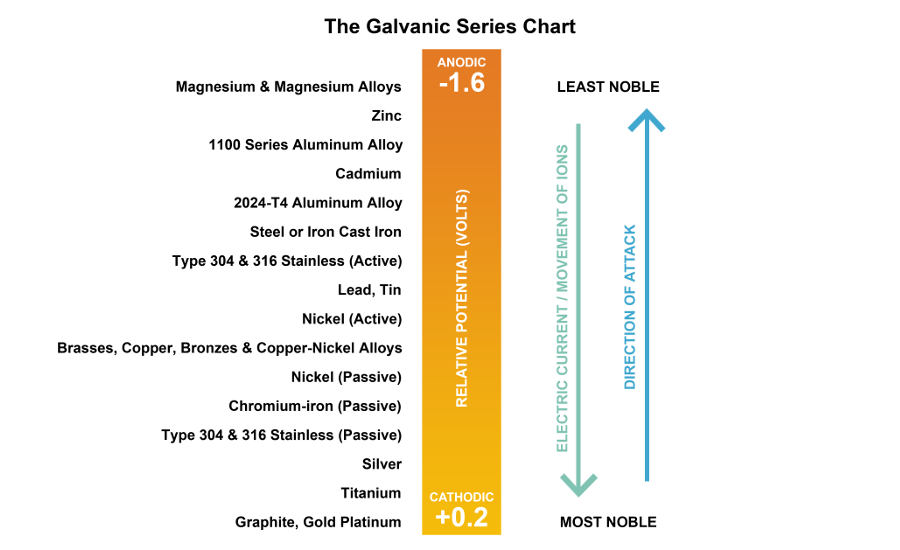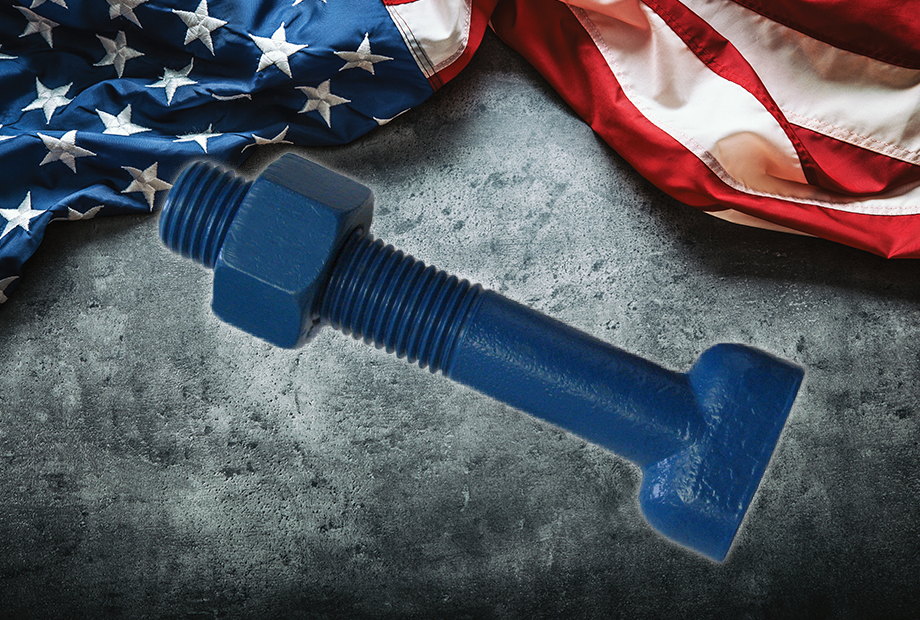Coated Bolts as an Alternative to Stainless Steel Bolts
Corrosion of underground systems is one of the most destructive and expensive problems facing waterworks projects today. A “solution” in one part of the country may be totally ineffective in another. There are many ways of dealing with corrosion; but, in order to deal with the problem, it is important to understand what causes the problem
At the most basic level, you must have three things in order to have corrosion. They are: 1. dissimilar metals, 2. a common electrolyte, and 3. electrical contact.
- Dissimilar metals are often shown in “galvanic series.” For example:

Generally, when you have two metals, the metal on the upper end of the series will be sacrificed to the metal at the lower end of the series. These series are not absolute however. Metals in a galvanic series can be rearranged when exposed to a different environment. Unfortunately, you don’t need two completely different metals to provide an anode and a cathode. It is possible to have anodes and cathodes in a single piece of metal. That is why a piece of steel will corrode when exposed to the atmosphere. - A common electrolyte allows the transfer of ions from the anode (sacrificed material at the upper end of the galvanic series) to the cathode (protected material near the lower end of the galvanic series).
- The dissimilar metals must be in electrical contact with one another so that there is a return path for the current that is generated between the different metals.
That is where protective coatings come in. You have this with fusion bonded epoxy coated appurtenances (fittings, valves, hydrants, …). The tightly adherent epoxy coating separates the metal of the fitting from the electrolyte and, as a result, protects it from corrosion.
Another way of protecting an underground system is to force an unimportant component of the system to corrode. That is where sacrificial anodes come into play. The sacrificial anode (usually zinc) is placed in electrical contact with the metal component that is being protected. Over time the anode corrodes away but the protected metal component remains relatively unscathed.
One of the metal components in a system that must be addressed is bolting. Bolts in valves. Bolts in hydrants. Bolts at joints. The list goes on. If the bolts deteriorate it doesn’t matter how protected the rest of the pipeline might be. Usually within an appurtenance like a valve the bolts are coated and protected in a manner that is similar to the coating of the iron castings that make up the appurtenance.
Corrosion studies in the past have demonstrated that even a poor coating is better than no coating at all. As a result, uncoated bolts corroded before asphalt coated fittings or restraints. Recently there has been a dramatic increase in the requirement of stainless-steel bolts at mechanical joints and/or restraints. This is a reaction to issues with corrosion of uncoated bolts that lead to failures.
There is good and bad with the use of stainless-steel bolts. The good is that the bolts are protected from long term corrosion because they are very cathodic (lower end) in most galvanic series. The bad is that using stainless-steel can cause corrosion of iron or steel components. If these components are coated, any kind of flaw (like a chip or scratch) in the coating will result in concentrated attack at the flaw because you have a very small anode (metal at the coating flaw) being sacrificed to a relatively large cathode (stainless-steel). While forcing corrosion to a sacrificial component (sacrificial anode) prolongs the life of a system forcing corrosion of iron pipeline components in order protect stainless-steel bolts can decrease the life of a system.
What is the alternative? Coated bolts are a very viable alternative to stainless-steel bolts. Remember, as mentioned earlier, any coating of steel bolts is better than no coating at all. It then stands to reason that a quality, tightly adherent coating on a bolt is better still.
At EBAA Iron, Inc we can provide steel bolts that have been coated by Metal Coatings Corp in Houston, TX. Their coating, FluoroKote#1®, is really a coating process that utilizes a metallic base coat with the fluoropolymer coating on top of that. The coating is incredibly durable and has been subjected to a battery of tests to demonstrate how it protects a bolt from corrosion. The following picture reveals how this coating improves a steel bolt’s resistance to corrosion when compared to plated or uncoated steel bolts.

You can find more information about FluoroKote#1 at https://www.metcoat.com/fluorokote-1.htm
Another bad for stainless-steel is that the material is very expensive. Especially when compared to regular steel. A stainless-steel bolt can cost almost TEN times as much as a standard steel bolt. On the other hand, a FluorKote#1 coated steel bolt costs just under TWICE that of a standard steel bolt. That is a considerable savings for a very durable and corrosion resistant bolting system.
The Galvanic Series Chart created by Daniel Overbey
FluoroKote#1® is a registered trademark of Metal Coatings Corp in Houston, TX
Information taken from NACE Basic Corrosion Course, Copyright 1970 by the National Association of Corrosion Engineers, Houston, TX and from FluoroKote#1 brochure from Metal Coatings Corp in Houston, TX
Since introducing its first patented product in 1968, EBAA has continued to lead the way in innovative products for the water and wastewater industry that are engineered to save time and money. EBAA is the only manufacturer of the world famous MEGALUG® Mechanical Joint Restraint. EBAA specializes in water and waste-water pipeline joints and is 100% MADE IN THE USA.










